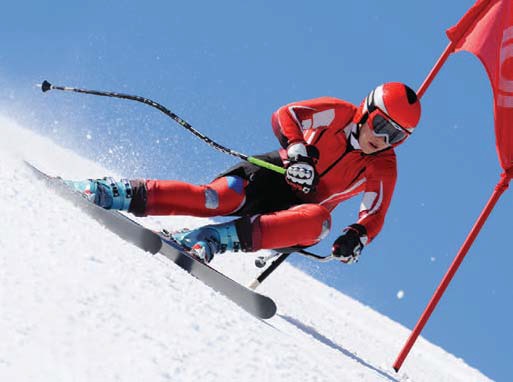Tribology’s Olympic research
Drs. Wilfred T. Tysoe & Nicholas D. Spencer | TLT Cutting Edge April 2010
A recent study sheds new light on the interaction of materials and roughness effects on ski friction.

Skiers commonly prepare their ski surfaces by roughening them.
www.canstockphoto.com
With the Winter Olympics behind us, now is a good time to reflect on the extent to which tribology contributed to the sports we enjoyed watching. Clearly the major reason for playing sports on ice and snow at all is that frozen water offers the possibility for human beings to move across the land at very high speeds.
Skiing, which dates as far back as the seventh millennium BC, was introduced as an Olympic sport in the 1924 Winter Games in Chamonix, France, and remains a very popular winter pastime in many parts of the world. While wooden skis were the norm up until the middle of the 20th Century, the use of polymers began as a ski base in the 1950s, and ultrahigh molecular weight polyethylene (UHMWPE) has remained the standard surface for snow contact, both for amateurs and professionals.
F. P. Bowden of the Cavendish Laboratory at Cambridge University was the first tribologist to examine the processes taking place at the ski-snow interface, and his early observations, beginning in the 1930s, are still cited heavily in skiing-tribology literature today. His theory that skis are actually lubricated by meltwater, generated by friction at the ski’s leading edge, is still regarded as the most likely cause of the very low friction between ski and snow. He also investigated the effect of different ski-base materials on ski speed, finding that among those tested, the fastest material was PTFE—the most hydrophobic material examined.
Hydrophobicity is widely believed to inhibit capillary drag between the ski and the meltwater-covered surface. Although attempts have been made to use this material since Bowden’s work, PTFE suffers from poor abrasion resistance and has, therefore, not supplanted UHMWPE. Skiers commonly prepare their ski surfaces by roughening them. A number of studies have examined the influence of roughness on ski friction but until recently no study had dealt with the interaction of materials and roughness effects. This situation was recently remedied by a fascinating study carried out by Jan Giesbrecht, Paul Smith and Theo Tervoort at ETH Zurich, Switzerland.
Using a custom-designed test ski on a real, freshly prepared Nordic ski track, they compared a series of different polymers with low roughness and different water contact angles and confirmed Bowden’s observation that the more hydrophobic the surface, the lower the friction and the faster the ski.
The next step was to introduce roughness, and this is where the results took an unexpected turn. Under the conditions investigated, at roughness values below 0. 2 μm (Ra), the behavior was exactly as described above, but in the roughness range 0.2-1 μm, the speed increased significantly and was completely independent of the material. Above 1 μm roughness, the speed reduces again and becomes dependent on the directionality of the roughness.
These findings suggest that capillary suction is the main contributor to friction for smooth ski bases, while plastic deformation of the snow is the main dissipation mechanism at roughness >1 μm. The sweet spot lies between these two regimes, although temperature is a factor since this also determines the amount of meltwater present on the snow surface. The consequence is that different degrees of roughness are appropriate for different temperatures of snow—a fact that was empirically determined by professional skiers sometime ago.
This research opens new opportunities for ski design since it shows that designed roughness can be used as a tool to overcome hydrophilicity concerns for polymers that might otherwise have useful properties for skis such as high-abrasion resistance.
FOR FURTHER READING:
Giesbrecht, J., Smith, P. and Tervoort, T. (2010), “Polymers on Snow: Towards Skiing Faster,”
Journal of Polymer Science Part B: Polymer Physics, Currently in press.
Bowden, F.P. and Hughes, T.P. (1939), “The Mechanism of Sliding on Ice and Snow,”
Proc. R. Soc.
London,
172 (949), pp. 280-298.
 Eddy Tysoe is a Distinguished Professor of Physical Chemistry at the University of Wisconsin-Milwaukee. You can reach him at wtt@uwm.edu
Eddy Tysoe is a Distinguished Professor of Physical Chemistry at the University of Wisconsin-Milwaukee. You can reach him at wtt@uwm.edu.
 Nic Spencer is professor of surface science and technology at the ETH Zurich, Switzerland. Both serve as editors-in-chief of STLE-affiliated Tribology Letters journal. You can reach him at nspencer@ethz.ch
Nic Spencer is professor of surface science and technology at the ETH Zurich, Switzerland. Both serve as editors-in-chief of STLE-affiliated Tribology Letters journal. You can reach him at nspencer@ethz.ch.